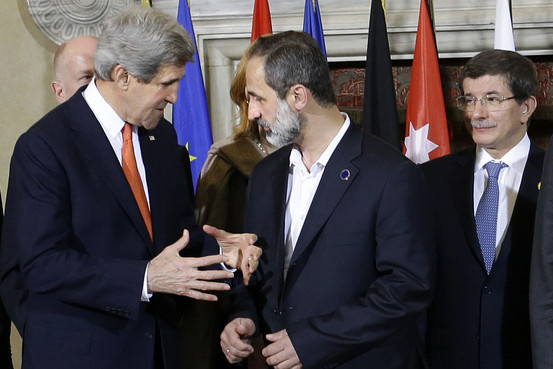What’s Behind US Aid to Bashar Opposition?

The Rome meeting entitled the Friends of Syria Conference was held on Thursday February 28th with the participation of more than 50 representatives of governments and international organizations opposing the government of Bashar Assad, including 11 foreign ministers and of course the representatives of Syria’s National Opposition Coalition. Muaz al-Khatib, the head of the coalition, at first had stated that he and his friends would not participate in this conference. The reason, according to him, was that their previous demands had been ignored. But with the new US Secretary of State’s message, the national coalition hastily entered Rome and Muaz al-Khatib had his first meeting with John Kerry. In this essay, I will attempt to look at the achievements of the Friends of Syria Conference.
The insistence of John Kerry – who had chosen the issue of the Syrian crisis and his presence in the Rome conference as his first serious international movement following his appointment as the head of the US State Department – on the opposition coalition’s participation in this conference was indicative that they were going to offer new proposals; proposals which were different from the previous ones: allocating 60 million dollars of aid to Assad’s opposition in addition to training, food, and drug aids and of course encouraging others, including the European Union, to take similar measures. There is no need to mention that some Arab governments have, since long ago, pursued the same trend without the U and the Rome conference’s persuasion. Nevertheless, this US measure and the Rome conference have achieved the following results:
1. There is no doubt that the recent US and EU logistical and financial aids to the Syrian opposition will encourage the coalition and the Free Syrian Army to further continue their armed struggle, killing, and violence and further distance themselves from the regime. As a result, the idea that Russia’s efforts to find a political solution would reduce the violence and destruction would at least be postponed.
2. In the statements made by the American and Western officials, there is still talk of the priority of a political solution and finding a way for negotiation between the opposition and the Syrian government, especially when they meet with the Russians (John Kerry’s meeting with Lavrov in Berlin and Hollande’s meeting with Putin in Moscow). This means that, first, negotiation with Bashar and the government in Syria would be indicative of their goodwill and, second, by giving logistical and military assistance to the opposition, which this time they have explicitly admitted to, the objective is their greater dominance on the ground and simultaneously promoting their negotiating power.
3. It is true that, in the Rome conference, the western front, along with some Arab governments of the region, have agreed to give more military assistance, but we must not forget that these aids, from the US point of view, must be utilized in two fronts: against the military forces of the government and against the radical Jihadi forces affiliated to al-Qaeda, who in fact have occupied the minds of the western states these days more than the Syrian regime and Bashar Assad. In the final statement of the Rome conference, the necessity of changing the balance in the scene was reiterated. This emphasis has a two-fold meaning. These days, everybody knows that the real operational forces in the opposition front of the Syrian government, the al-Nusra front, the Farouq Brigades, Ahrar-al-Sham, are all the same radical Salafi forces close to the al-Qaeda movement which are considered a serious threat for the future presence of the US and the West. From the aspect of the western front, this equation must be changed on the ground to the benefit of the National Coalition and the Free Army.
4. Meanwhile, the Americans have shown that they are hesitant about giving advanced weaponry to the Syrian opposition. It seems that the reason is clear. Their concern is the Jihadist radical movements. The problem of the Americans is that these so-called al-Qaeda Jihadist Salafi movements who are strongly motivated towards military confrontation act independently and have also infiltrated the military lines of the groups called the Free Army and distinguishing them is not possible. There is an ideology within which moderates are placed alongside radicals inside the opposition movement and there are of course sometimes conflicts among them.
The result is that the situation in the Syrian scene is complicated. Under these non-transparent and complex future conditions, the US plan in Syria can, in the worst case, be the continuation of the present situation, prolongation of the disputes and consequently gradual destruction of the basic infrastructures of the country. This will occur through deadly confrontation between the Syrian-Syrian movements and finally the weakening of both sides, and the enemies, particularly the Zionists, will benefit the most. Meanwhile, the costs of the mentioned strategy are apparently paid by some of the Persian Gulf Arab littoral states.

